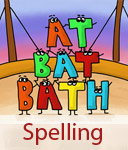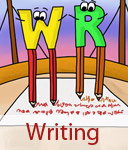

Handwriting worksheets
Year 2
Handwriting worksheets for Year 2 learning cursive writing in Primary School. Homework help with handwriting in KS1. Learn spacing, correct letter size, seating and posture.
Pick a level
Is your handwriting neat?
It's important to keep a check on your handwriting to check that it is neat and that people can read it. Let's do a check of your handwriting. Write the following sentence on a piece of lined paper:
Mr Fox gave a big smile, flashing his white teeth. Rat popped back fast out of sight.
Now have a look at your writing and give yourself one point for everything that is right.
- All the letters are sitting on the line. - 1 point
- All the small letters are the same size. - 1 point
- All the words and letters and spaced out evenly. - 1 point
- Someone else can read my writing. - 1 point
How did you do? Did you score 4/4? If you didn't don't worry, keep reading and we will go through how to make your writing look better.

Seating position
Are you sitting comfortably? Ideally, your chair and table should be the correct height for you. You should be able to place your feet on the floor and the table should be at about elbow height. This makes a big difference to your handwriting. Have you tried writing on the floor while sitting on your knees? It's very awkward and hard to write neatly. So try and find somewhere you can writing that is perfect for you.
Paper position

Paper should be placed on the table at a slight angle to the left or right depending if you are right or left-handed. This make your handwriting more upright and it's a much more natural way to position your hand and wrist. Try writing with the paper straight and then at a slight angle. Can you see the difference in your handwriting?
Sitting on the line

Sit your letters on the line for neater handwriting. Don't let the letters fly off the line like balloons.
Try sitting with the paper slanted to the right, if you are right-handed, or slanted left if you are left-handed. This will make it easier to keep your letters on the line.
Making the letters the same size

Are all your small letters the same size? Draw a line along the top of the small letters to see if they are. If you are having problems keeping your letters the same size then try writing on ruled paper with guidelines for a while until you become an expert at this.
Spacing

Letters and words should be evenly spaced. Letters in words should not have any big gaps or they could look like separate words. Learning cursive handwriting will help with this and it will teach you to join all the letters up in a word. Click here to have a go at cursive handwriting and start with the letters.
Leave enough space for a letter o between your words. See how many o's you can place in between your words. You only need to fit one in. So if can add lots of o's then make your gaps smaller.
If you more practice with this place lolly stick after your words so you can see where to write the next one.
Handwriting practice
Practice your handwriting every day to work at having neater writing. Either print off our blank guided paper or copy sentences from your favourite storybook. Or print off our sentences worksheet and copy the text.
Print off your own blank handwriting paper to practice your handwriting.
Go over the words in the sentences then have a go at writing them on the lines inbetween.







